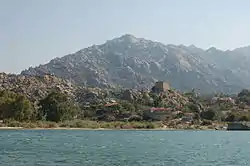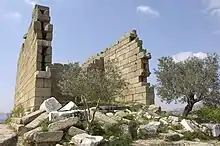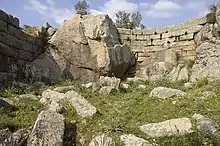Heraclea at Latmus
Heraclea at Latmus (Ancient Greek: Ἡράκλεια πρὸς Λάτμῳ, romanized: Herakleia pros Latmo; Latin: Heraclea ad Latmum), or simply Heraclea or Herakleia (Ἡράκλεια), also transliterated as Heracleia, was a town on the confines between ancient Caria and Ionia, situated at the western foot of Mount Latmus on the Gulf of Latmus, which has since silted up. It was a small place in the south-east of Miletus, and south-west of Amyzon. Ruins of the town still exist at the foot of mount Latmus on the borders of Lake Bafa, which is probably a portion of the ancient Sinus Latmicus, formed by the deposits of the river Maeander.

Its site is co-located with the village of Kapıkırı, Asiatic Turkey.[1][2]
History
Originally called Latmos, during the 5th century BCE the city was listed in a register as being a member of the Delian league.[3] Then in the 4th century BCE, Mausolos conquered the town and it was renamed Heraclea.[4] Mausolos is often credited with building the walls of Heraclea which still stand to this day. The walls of Heraclea had 65 towers which are still remarkably well preserved.
The town was later called Pleistarcheia,[4] a name which is mentioned by Stephanus of Byzantium who writes that the city was originally called Herakleia, then Pleistarcheia, and then Herakleia again. The name Pleistarcheia is attributed to Pleistarchus, brother of king Cassander, who is recorded as being the king of the region of Caria after the battle of Ipsus which took place in 301BCE.[4]
The town also holds the resting place of Endymion, a mythical figure who was put to sleep by Zeus for eternity, and Pausanias writes that the people of Heraclea honor him at a shrine in this spot.[5][6][7][8]
Heraclea is thought to have been Christianised early, as an early bishopric is attested. No longer a residential see, it remains a titular see of the Roman Catholic Church.[9]
Structure
The city was built on a Hippodamian grid,[10][3] the temple of Athena being the only structure in the city that does not follow this method. The temple of Athena is the city’s main temple and sits west of the agora.
In the city center is a large agora containing two-story shops. The city also contains three temples, a bathhouse, a bouleuterion, a necropolis, and a nymphaeum.[11]
Gallery
 Herakleia at Latmus – Defensive towers
Herakleia at Latmus – Defensive towers Herakleia at Latmus – Defensive tower
Herakleia at Latmus – Defensive tower Herakleia at Latmus – Defensive tower
Herakleia at Latmus – Defensive tower Herakleia at Latmus – At agora
Herakleia at Latmus – At agora Herakleia at Latmus – At agora
Herakleia at Latmus – At agora Herakleia at Latmus – At agora
Herakleia at Latmus – At agora Herakleia at Latmus – Agora
Herakleia at Latmus – Agora Herakleia at Latmus – Temple of Athena seen from the agora
Herakleia at Latmus – Temple of Athena seen from the agora Herakleia at Latmus – Athena temple
Herakleia at Latmus – Athena temple Herakleia at Latmus – Athena temple
Herakleia at Latmus – Athena temple Herakleia at Latmus – View south to Byzantine castle from Temple of Athena
Herakleia at Latmus – View south to Byzantine castle from Temple of Athena Herakleia at Latmus – Necropolis
Herakleia at Latmus – Necropolis Herakleia at Latmus – Unidentified remains
Herakleia at Latmus – Unidentified remains Herakleia at Latmus – Near Endymion temple
Herakleia at Latmus – Near Endymion temple Herakleia at Latmus – Endymion temple
Herakleia at Latmus – Endymion temple Herakleia at Latmus – Monastery on island in Lake Bafa
Herakleia at Latmus – Monastery on island in Lake Bafa Herakleia at Latmus – Byzantine Castle
Herakleia at Latmus – Byzantine Castle Herakleia at Latmus – Byzantine Castle
Herakleia at Latmus – Byzantine Castle Kapiri village
Kapiri village Kapiri village with Lake Bafa in the background
Kapiri village with Lake Bafa in the background
References
- Richard Talbert, ed. (2000). Barrington Atlas of the Greek and Roman World. Princeton University Press. p. 61, and directory notes accompanying.
- Lund University. Digital Atlas of the Roman Empire.
- "The Princeton Encyclopedia of Classical Sites, HERAKLEIA UNDER LATMOS Caria, Turkey". www.perseus.tufts.edu. Retrieved 2021-12-09.
- Hülden, Oliver (2012-01-01). "Herakleia by Latmos". The Encyclopedia of Ancient History.
- Periplus of Pseudo-Scylax, p. 39; Strabo. Geographica. Vol. xiv. p.635. Page numbers refer to those of Isaac Casaubon's edition.
- Ptolemy. The Geography. Vol. 5.2.9.
- Pliny. Naturalis Historia. Vol. 5.31.
- Polyaen. 7.23; Schol. ad Apollon. Rhod. 4.57; Pausanias. Description of Greece. Vol. 5.1.4.
- Catholic Hierarchy
- "Heracleia by Latmus | Turkish Archaeological News". turkisharchaeonews.net. Retrieved 2021-12-09.
- "Herakleia under Latmus (Site)". www.perseus.tufts.edu. Retrieved 2021-12-09.
![]() This article incorporates text from a publication now in the public domain: Smith, William, ed. (1854–1857). "Heracleia". Dictionary of Greek and Roman Geography. London: John Murray.
This article incorporates text from a publication now in the public domain: Smith, William, ed. (1854–1857). "Heracleia". Dictionary of Greek and Roman Geography. London: John Murray.